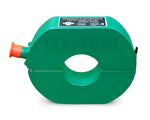
MIL-STD-461 CS116 Equipment Rental
Related:



Solar 9354-2 - Rent MIL-STD-461 CS116 Transient Generator
- 3 Double Exponential Pulse 6.4 μs, 70 μs, & 120 μs
- 6 Damped Sinusoidal Pulses 10 kHz - 100 MHz
- Compliant to MIL-STD-461 CS116
In Stock


EMC Partner MIL-MG3 - Rent MIL-STD & DO-160 Test System
- Exceeds maximum test levels in MIL-STD-461
- Single Generator for CS115 & CS116 Requirements
- Automated Test Routines from Front Panel


Solar 9554-1M/6M - Rent Variable Frequency Module
- Covers 1 MHz to 6 MHz Frequency Range
- Used with Solar 9354-2/-1 Pulse Generators
- Meets Requirements for MIL-STD-461 CS116
In Stock


Solar MIL-STD-461 CS116 & CS115 Accessory Package
- Includes Injection Probes, Monitoring Probe, & Attenuators
- Common MIL-STD-461 CS116 & CS115 Required Accessories
- Ideal for Rental with Solar 9354-2 & 9355-1 Generators
In Stock


Solar LISN 9233-50 - Rent 50μH 50Amp LISN 10kHz –50MHz
- Frequency 10 kHz – 50 MHz
- 0.25 µF Coupling Capacitor
- Designed for MIL-STD-461D/E/F/G
In Stock


Solar 8610-50 - Rent 50uH 500 Volt 100 Amp LISN
- Frequency Range 10 kHz – 30 MHz
- Max 500 Volts AC (600 Volts DC) 100 Amps
- Ideal for MIL-STD-461 Series of Tests
In Stock


Com-Power LI-350 - Rent 5µH 50 Amp 400 MHz LISN
- Frequency Range 10 kHz – 400 MHz
- Max 480 V/50 A AC or 676 V/35 A DC
- Inductance 5μH & Coupling Capacitor . 0.25 µF


Teseq HV-AN 150 - Rent 5uH 150 Amp Artificial Network
- Max 1000 V/150 A DC or 500 V/150 A AC
- HV Compliant to ISO 7637-4 & CISPR 25
- Jumpers Provide LISN Path Configuration
In Stock


Pearson 8705C - Rent 400 MHz Current Probe for MIL-STD-461
- Frequency Range 10 kHz - 400 MHz
- Maximum RMS Current 4 Amps
- Designed for MIL-STD-461 CS114, CS115, CS116

Solar 9142-1N - Current Injection Probe 2 MHz - 500 MHz
- Frequency Range 2 MHz - 500 MHz
- Maximum Power 200 Watts
- Component of CS115 & CS116 Accessory Package
In Stock

Solar Electronics 9123-1N Current Probe 10 kHz - 450MHz
- Frequency Range 10 kHz - 450 MHz
- Probe Peak 60A Max; CW Current Max 40A
- Rented with CS115 & CS116 Test Kit
In Stock

Solar 9410-1 High Voltage Attenuator 50/50 Ω
- Rented with CS115 & CS116 Accessory Package
- Maximum 2500 Volt Peak, 40dB
- 50 Ohm Impedance
In Stock

Solar 9454-1 High Voltage Attenuator 50/600 Ω
- Calibration Fixture
- Rented with CS115/CS116 Test Package


Com-Power LI-3100 - Rent 5µH 100 Amp 400 MHz LISN
- Frequency Range 10 kHz – 400 MHz
- Max 480 V AC / 600 V DC 100 Amps
- Air Core Inductors to Prevent Saturation


Com-Power CFT-10U - Rent 10μF Feed-Thru Capacitor
- 10 μF Capacitors for Susceptibility Tests
- Max 250 V AC / 600 V DC 100 Amps
- Designed for MIL-STD-461/DO-160
In Stock

